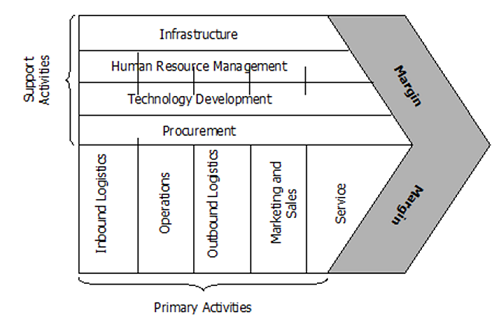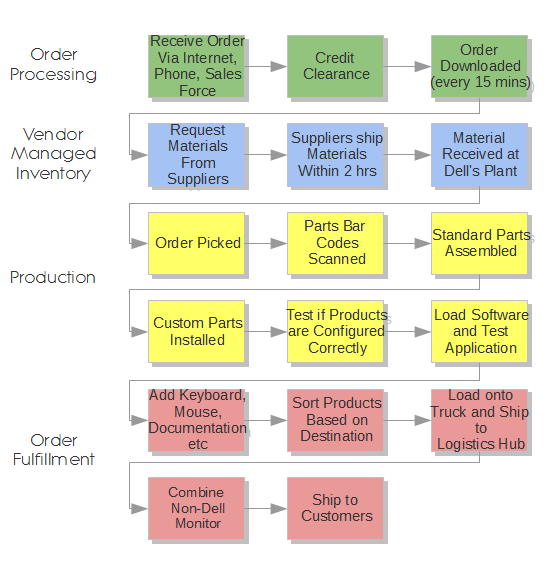Dell Value Chain Analysis
Value-chain analysis is an analytical framework that assists in identifying business activities that can create value and competitive advantage to the business. The Figure 1 below illustrates the essence of value chain analysis. It is important to note that the pattern of Dell value chain management has been extensively imitated by other companies, including companies outside of consumer technology industry due to its evident contribution to the success of the company.
Figure 1 Value Chain Analysis
Inbound logistics. Dell works with more than 165,000 channel partners in inbound logistics and provides USD 125 million partner incentives and investments annually[1]. The company utilizes Just-in-Time (JIT) philosophy in dealing with inbound logistics. Thanks to this strategy, Dell is able to save on huge inventory costs and sustain cost leadership for the majority of its products and services. Customer orders are registered by Dell and its vendors simultaneously by an integrated system. Then, materials are shipped by suppliers within 2 hours and shortly received at Dell’s assembly unit due to geographical proximity (see Figure 2 below).
Operations. The main distinctive point between operations of Dell and its competitors relates to the fact that Dell is not a computer manufacturer; the company merely assembles parts manufactured by other companies. At the same time, high level of product customization is adapted as one of the bases of competitive advantage by the business. Therefore, operations mainly consist of three stages – assembly of stardard parts, installation of custom parts and testing product configurations (see Figure 2 below).
Figure 2 Dell’s value chain[2]
Outbound logistics consists of five stages as marked in red color in Figure 2 above. Thanks to the practice of mass customization, Dell is able to complete order fulfilment in a short duration of time. Generally, Dell completes customer shipments in a timely basis, staying committed to its promise of product customization as a result of cumulative advantages of part modularity, inventory program managed by vendors, demand management and mass customization.
Marketing and sales is acknowledged by Dell as a critically important primary activity and the company’s marketing strategy has changed since the company became private in August 2013. Specifically, Dell marketing management aims to associate the brand image with an entrepreneurial spirit by shifting attention to the fact that the company is no longer publicly listed, hence the management is freed from the need to track stock prices on a daily basis.
Service. Pre and post sales customer support can be specified as one of the solid bases of Dell’s competitive advantage. It has been noted that Dell’s employees “take 50,000 phone calls from customers every day and document and organize their comments, which are then distributed to managers”[3]. Also, there are 4300 Dell certified partners globally who assist with Dell solutions and services to customers[2]…
Dell Inc. Report contains more detailed discussion of Dell value chain analysis covering analysis of support activities. The report also comprises application of SWOT, PESTEL and Porter’s Five Forces Analyses on Dell , along with analysis of Dell’s marketing strategy and company’s approach towards Corporate Social Responsibility (CSR).
[1] Annual Report (2015) Dell Inc.
[2] Source: Supply Chain Minded, Available at: http://supplychainminded.com/supply-chain-management-case-study-executives-guide/
[3] Farkaz, C. M. & Wetlaufer, S. (1996) “The Ways Chief Executive Officers Lead”, Harvard Business Review, Available at: https://hbr.org/1996/05/the-ways-chief-executive-officers-lead
[4] Annual Report (2015) Dell Inc.



